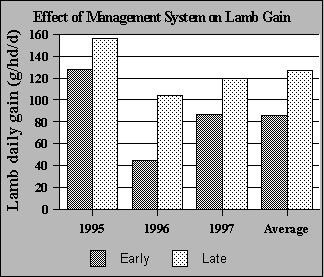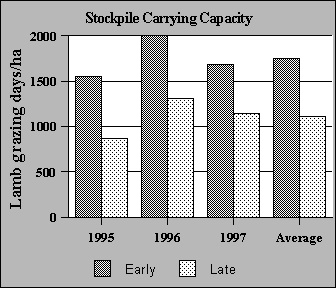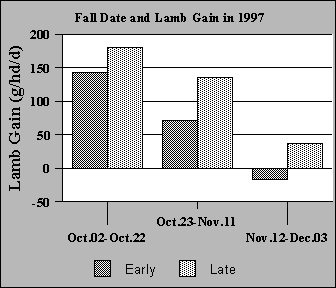Stockpiled pasture: Lamb performance on two stockpiling systems
Learn research results from a stockpiling pasture project that looked at lamb performance on fall-saved pasture.
Introduction
Stockpiling is the practice of saving certain hay or pasture fields for grazing in the fall and winter after forage growth has stopped due to cold weather. Stockpiled pasture is also referred to as fall-saved pasture or deferred grazing. The primary reason for using stockpiled forages is to reduce feed costs. Harvesting costs are lower for grazed forage as compared to hay or silage, manure spreading is reduced, and some overhead costs such as buildings and yards are lower. In this report, we look at the performance of weaned lambs grazing stockpiled forage.
Two stockpiling management systems, called "Early" and "Late" were evaluated. In each of three years (1995 to 1997), our experimental pastures (6 Early and 6 Late: each 0.75 acres) were cut for silage in mid-June. Following that harvest, the "Early" pastures were mob grazed by sheep in mid-July for a duration of about 7 days. The "Late" treatments were mob-grazed in mid-August for the same duration. In both systems, the residual pasture height was about 5 cm following the mob-grazing. After the mob-grazing in summer, 3 of the "Early" and 3 of the "Late" pastures received 50 kg/ha actual N, while the rest of the pastures received no nitrogen. The pastures were then left to accumulate forage (stockpile) until late September.
Weaned lambs weighing about 70 to 80 pounds were randomly assigned to graze the stockpiled pastures each year from 1995 to 1997. Each pasture was divided into 8 paddocks, with each paddock providing 5 to 7 days of grazing. Lambs were weighed every 21 days.
Results
Lamb weight gain
Overall lamb gains during the late September to late November period ranged from 44 grams/head/day (g/hd/d) to 156 g/hd/day. Gains were highest in 1995 and lowest in 1996. Lambs gained weight significantly faster under the Late management regime than under the Early management regime (Figure 1).
Pasture samples collected prior to grazing revealed that forage quality was significantly higher under the Late management system (see separate report for details). Applying nitrogen to the pasture at the beginning of the stockpiling period (mid July or mid August) did not have a significant effect on lamb average daily gain (data not shown).
Stockpile carrying capacity
The carrying capacity of the stockpiled pasture was measured as "lamb days per hectare" (for example: 1000 lamb days per hectare means that 1 hectare of stockpiled pasture would carry 1000 lambs for 1 day). The Early stockpiled pastures had significantly higher carrying capacity than the Late pastures (Figure 2).
Averaged over three years, the Early system had a 57% higher carrying capacity than the Late system. Maximum carrying capacity averaged almost 2000 lamb days per hectare. In 2 of the 3 years, applying nitrogen significantly increased the carrying capacity of the stockpiled pasture (data not shown). Averaged over three years the 50N treatment had a carrying capacity 18% greater than the 0 N treatments.
Effect of fall date on lamb gain
Lambs gains were highest at the beginning of the fall grazing period (first 3 weeks of October) and slowed down as the fall progressed (Figure 3).
In all weigh periods, lambs on the Late stockpile treatments gained more than those on the Early treatments. By the final weigh period (November 13 to December 03), the lambs on the Late management system were still gaining 37 g/hd/day, while the lambs on the Early management system were losing 17 g/hd/day. This illustrates the difference in forage quality between the two management systems and over time in the fall.
Summary and interpretation
The results presented above show that stockpiling management can be used to create two situations: i) a stockpile with high growth potential but limited carrying capacity or ii) a stockpile with a high carrying capacity but lower growth potential. By changing the date at which the stockpile begins growth to late July or early August (between the two dates we used), an intermediate level of carrying capacity and growth potential could be achieved.
Which management system to use will depend on the type of animals to be grazed and the stage of the production cycle they are at when the stockpile is being grazed. For example, if non-lactating, bred ewes or cows are to be grazed on stockpiled pasture in November, the management should provide for maximum carrying capacity and moderate quality. However, if the stockpile is to be grazed by weaned lambs (or calves) or flushing and breeding ewes, then management to produce higher growth potential is of greatest importance. Proper stockpile management becomes more critical when high growth potential is required from late fall and early winter grazing.
Based on the animal performance achieved in the above trial, there seems to be no reason why most classes of livestock could not be kept on pasture until early November and maintain their performance. For animals with moderate or low performance targets, grazing into early December is a realistic goal.


